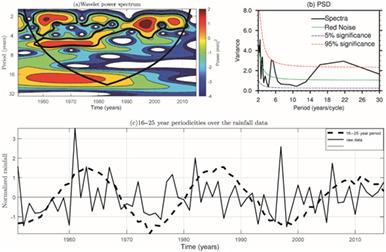当前位置:
X-MOL 学术
›
Int. J. Climatol.
›
论文详情
Our official English website, www.x-mol.net, welcomes your
feedback! (Note: you will need to create a separate account there.)
Analysis of rainfall variability for the October to December over Tanzania on different timescales during 1951–2015
International Journal of Climatology ( IF 3.5 ) Pub Date : 2021-05-04 , DOI: 10.1002/joc.7173 Dickson Mbigi 1, 2, 3 , Ziniu Xiao 1
International Journal of Climatology ( IF 3.5 ) Pub Date : 2021-05-04 , DOI: 10.1002/joc.7173 Dickson Mbigi 1, 2, 3 , Ziniu Xiao 1
Affiliation

|
This study has utilized spectral analysis to ascertain the nature of decadal rainfall variability, while correlation, singular value decomposition (SVD), and composite analyses were employed to explore and understand the possible associated mechanisms. Inferences were drawn to the interannual timescales. The spectrum analysis of October to December (OND) rainfall revealed dominant signals at 2.4, 2.9, and 5.0, and a band near 16–25 years. These cyclicities suggest that dominant drivers of Tanzania rainfall anomalies evolve on interannual and decadal timescales. Interannual variations in Tanzania rainfall are mostly linked to the Indian and Pacific oceans. Significant sea surface temperature (SST) anomalies in the Indian and Pacific oceans included those associated with Indian Ocean Dipole (IOD) and El Niño-Southern Oscillations (ENSO), respectively and are linked to changes in the atmospheric circulation anomalies over the western Indian Ocean. The observed circulation variations are most likely to influence Tanzania rainfall. In contrast, wet and dry decades are mostly linked to the Indian and Atlantic oceans. The Indian ocean provides stronger teleconnections with Tanzania rainfall at decadal timescales, consistent with interannual timescales teleconnections. Notably, the ‘dipole’ like forcing observed at interannual timescales is less coherent at decadal timescales over the Indian Ocean. As such, the Indian Ocean displayed a coherent monopole pattern in decadal SST. As a result of these differences, the location of the western Indian ocean centre of convection activities observed at interannual timescales has shifted to around the central Indian Ocean at decadal timescales. Wet decades in Tanzania rainfall are associated with the condition of enhanced convection and increase moisture content centred over the central Indian Ocean. This convective condition was observed to spread to a large area of the Indian Ocean and the African continent, including the study area.
中文翻译:

1951-2015年坦桑尼亚10-12月不同时间尺度降雨变率分析
本研究利用光谱分析来确定年代际降雨变化的性质,同时采用相关性、奇异值分解 (SVD) 和复合分析来探索和了解可能的相关机制。对年际时间尺度进行了推论。10 月至 12 月 (OND) 降雨的频谱分析揭示了 2.4、2.9 和 5.0 的主导信号,以及接近 16-25 年的波段。这些周期性表明坦桑尼亚降雨异常的主要驱动因素在年际和年代际时间尺度上演变。坦桑尼亚降雨的年际变化主要与印度洋和太平洋有关。印度洋和太平洋的显着海面温度 (SST) 异常包括与印度洋偶极子 (IOD) 和厄尔尼诺-南方涛动 (ENSO) 相关的异常,分别与西印度洋上空大气环流异常的变化有关。观测到的环流变化最有可能影响坦桑尼亚的降雨。相比之下,干湿几十年大多与印度洋和大西洋有关。印度洋在年代际时间尺度上与坦桑尼亚降雨提供更强的遥相关,与年际时间尺度遥相关一致。值得注意的是,在年际时间尺度上观察到的类似“偶极子”的强迫在印度洋上的年代际时间尺度上不太一致。因此,印度洋在十年海温中显示出连贯的单极子模式。由于这些差异,在年际时间尺度上观测到的西印度洋对流活动中心的位置在年代际时间尺度上已转移到印度洋中部附近。坦桑尼亚的降雨十年与印度洋中部的对流增强和水分含量增加有关。观察到这种对流条件蔓延到印度洋和非洲大陆的大片区域,包括研究区。
更新日期:2021-05-04
中文翻译:

1951-2015年坦桑尼亚10-12月不同时间尺度降雨变率分析
本研究利用光谱分析来确定年代际降雨变化的性质,同时采用相关性、奇异值分解 (SVD) 和复合分析来探索和了解可能的相关机制。对年际时间尺度进行了推论。10 月至 12 月 (OND) 降雨的频谱分析揭示了 2.4、2.9 和 5.0 的主导信号,以及接近 16-25 年的波段。这些周期性表明坦桑尼亚降雨异常的主要驱动因素在年际和年代际时间尺度上演变。坦桑尼亚降雨的年际变化主要与印度洋和太平洋有关。印度洋和太平洋的显着海面温度 (SST) 异常包括与印度洋偶极子 (IOD) 和厄尔尼诺-南方涛动 (ENSO) 相关的异常,分别与西印度洋上空大气环流异常的变化有关。观测到的环流变化最有可能影响坦桑尼亚的降雨。相比之下,干湿几十年大多与印度洋和大西洋有关。印度洋在年代际时间尺度上与坦桑尼亚降雨提供更强的遥相关,与年际时间尺度遥相关一致。值得注意的是,在年际时间尺度上观察到的类似“偶极子”的强迫在印度洋上的年代际时间尺度上不太一致。因此,印度洋在十年海温中显示出连贯的单极子模式。由于这些差异,在年际时间尺度上观测到的西印度洋对流活动中心的位置在年代际时间尺度上已转移到印度洋中部附近。坦桑尼亚的降雨十年与印度洋中部的对流增强和水分含量增加有关。观察到这种对流条件蔓延到印度洋和非洲大陆的大片区域,包括研究区。











































 京公网安备 11010802027423号
京公网安备 11010802027423号